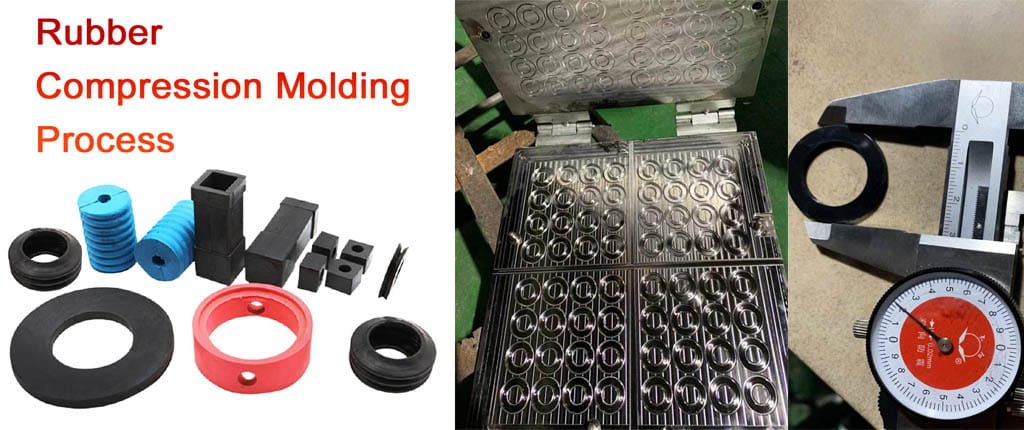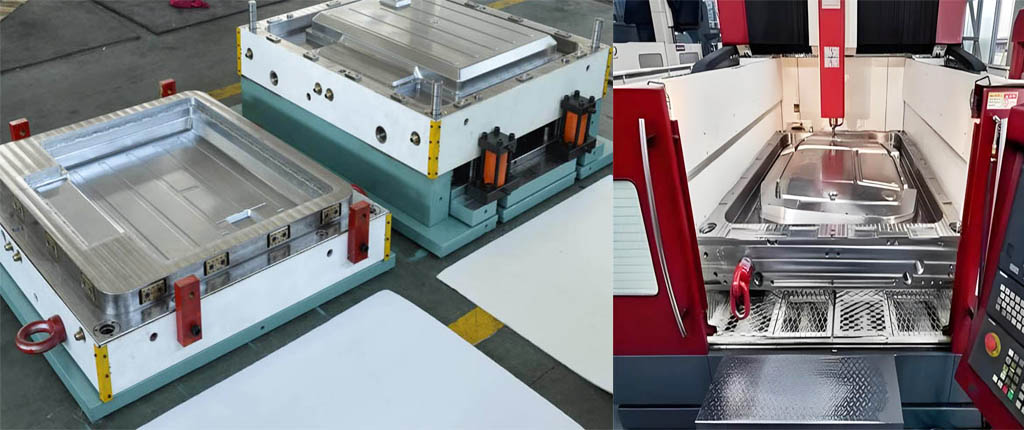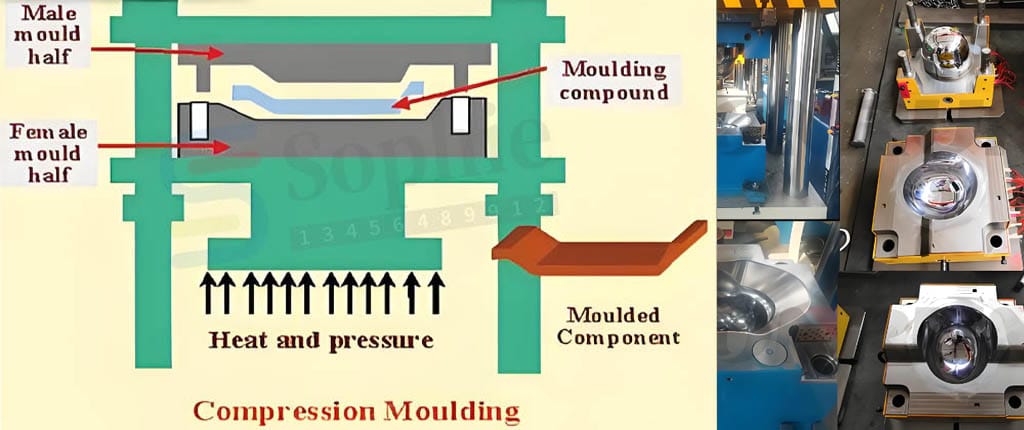In the rubber manufacturing industry, compression molding technology stands out for its efficiency and economy. This article takes a deep dive into various aspects of rubber compression molding, including technology, processes, and benefits, aiming to provide professionals, engineers, and industry enthusiasts with the necessary detailed knowledge to understand and optimize rubber compression molding operations. We will explore the complex processes involved, from material selection and mold design to the actual compression and curing stages. In addition, this article will highlight the many advantages of using rubber compression molding, such as cost-effectiveness, material diversity, and enhanced product durability.
Table of Contents
ToggleRubber Compression Molding and How It Works
Rubber compression molding is a manufacturing process in which a pre-weighed amount of uncured rubber compound is placed in a heated mold cavity. The mold is then closed and heat and pressure are applied to the mold, causing the rubber to flow and fill the cavity. This combination of heat and pressure also initiates the curing process, transforming the uncured rubber into a solid, durable component with the desired shape and properties. Once the molding process is complete, the mold opens and the finished product is ejected,akin to how a waffle maker shapes batter into waffles.
Rubber Compression molding is an excellent, cost-effective manufacturing method for making a variety of rubber products.
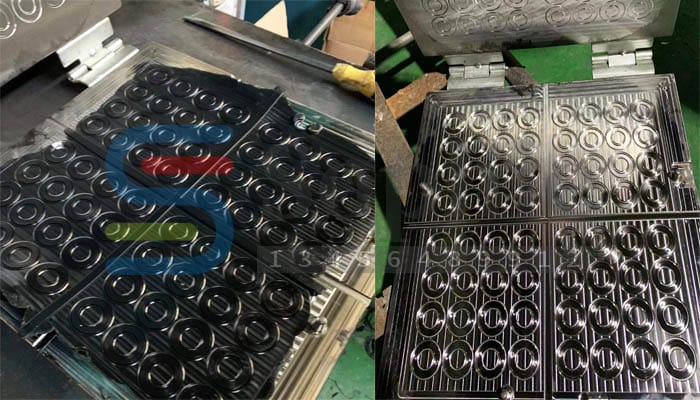
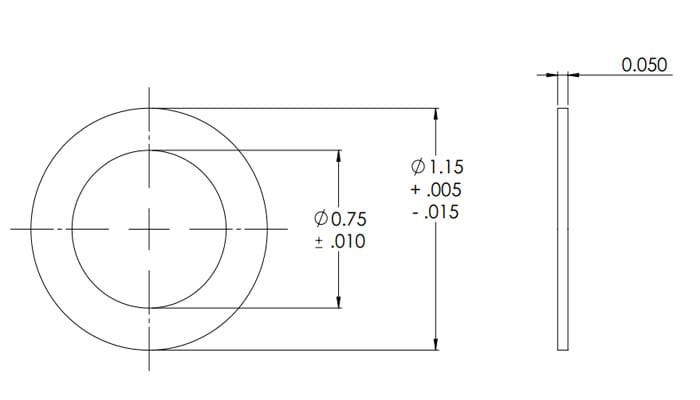
Understanding the Compression Molding Process
The compression molding process begins with the careful selection of the rubber compound, taking into account factors including material properties, intended application, and performance requirements. After material selection, the uncured rubber compound is accurately weighed and preformed into the shape and size that fits the mold cavity. The mold, usually made of hardened steel or aluminum, is then heated to a specific temperature to accommodate the rubber compound being used.
After the preformed rubber is placed in the mold cavity, the mold is closed and a pressure of 1000 to 4000 psi is applied. This pressure forces the rubber to flow into all contours of the mold cavity, ensuring even distribution. During this stage, the high temperature activates the curing agent within the rubber compound, initiating the vulcanization process. This chemical reaction cross-links the polymer chains, giving the material its final mechanical properties and stability
The role of compression molds in rubber part manufacturing
The design of a compression mold is based on the shape and specifications required for the final product. It is usually made of durable materials such as steel or aluminum to withstand repeated use and high pressure. The mold is then thoroughly cleaned to remove any residue, and the compression mold is preheated to the required temperature.
Process of Rubber Compression Molding
While the act of compression molding itself is relatively simple, a multitude of preparatory actions and intricate computations are required by engineers prior to initiating the rubber compression molding process. The sequence of tasks leading up to the compression phase encompasses the following stages:
- Preparing the Mold: The mold is designed according to the shape and specifications required for the final product. It is usually made of durable materials such as steel or aluminum to withstand repeated use and high pressure. The mold is then thoroughly cleaned to remove any residue, and the compression mold is preheated to the required temperature.
- Preparing the Rubber Compound: The raw rubber is mixed with additives such as vulcanizers, fillers, and stabilizers to achieve the desired properties. It is formed into preforms or blocks to fit the shape and size of the mold cavity.
- Moulding: The rubber preform is placed in the heated mold cavity. Accurate placement is critical to ensure that the material fills the mold correctly. The mold is then closed and high pressure is applied to force the rubber to flow and completely fill the mold cavity.
- Curing the Rubber: The mold and rubber are heated to a specific temperature to start the curing (vulcanization) process. This process cross-links the rubber molecules, giving the material its final properties. The mold remains closed under heat and pressure for a certain period of time, called the curing time, to ensure that the rubber is evenly and completely cured.
- Demolding: The mold is opened and the molded rubber part is ejected.
- Post-molding processing: Any excess rubber, called flash, is trimmed off and the part may need to undergo additional finishing such as inspection, post-curing, etc. to meet the required specifications.
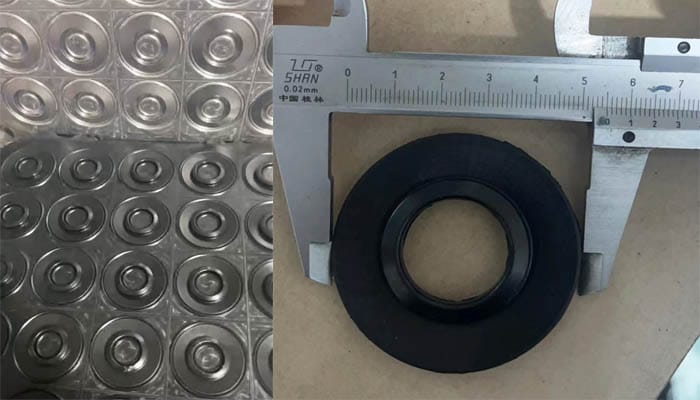
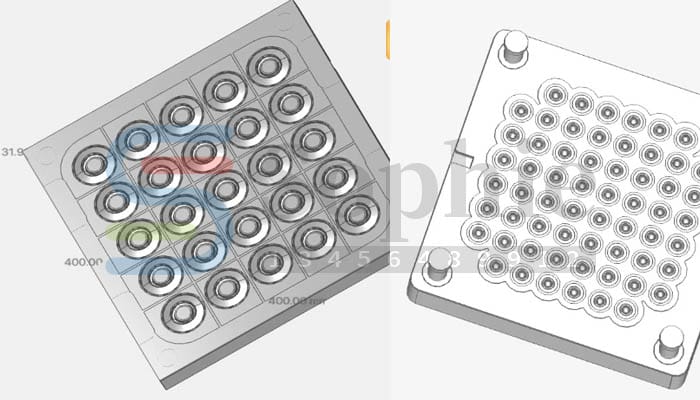
Advantages of Rubber Compression Molding
Rubber compression molding offers the following advantages:
- Lower tooling costs compared to rubber injection molding
- Quick mold changes
- Eliminates material runners compared to traditional transfer or injection molding
- Able to handle most elastomers and cure systems
- Suitable for materials that require longer cure times
- Suitable for overmolding rubber onto substrates, i.e. rubber to metal bonding
Types of Elastomers
Elastomers, which are elastic polymers, are materials that exhibit rubber-like properties and are widely recognized for their suitability in molding processes due to their flexibility, post-molding performance, and superior failure strain compared to other materials.
Natural Rubber
Natural rubber is derived from isoprene, an organic compound, and is composed of polymers. It has numerous applications in both its raw and vulcanized states, with the latter being more versatile.
Synthetic Rubber
Synthetic rubbers, or elastomers, are designed to achieve performance levels and functionalities that natural rubbers cannot provide. They are often referred to as “purpose-engineered” materials. The most prevalent types of synthetic rubbers include:
Silicone Rubber
Silicone elastomers, also known as silicone rubber, are polymers based on silicone that have undergone vulcanization. They are valued for their resistance to high temperatures, wear, and chemical exposure, as well as their stability and longevity, making them a popular choice across various industries.
Ethylene Propylene Diene Monomer (EPDM) Rubber
EPDM is a synthetic rubber variant that exhibits greater resistance to heat, UV light, and ozone than many other rubbers, both natural and synthetic. It is predominantly used for sealing and protective applications, which is why it is frequently found in roofing membranes, automotive seals, and weatherstripping. For further comparison, explore the differences between natural rubber and EPDM rubber.
Fluorocarbon (Viton) Rubber
Fluorocarbon rubber boasts exceptional high-temperature resistance and chemical resistance, making it a preferred choice for sealing applications in aircraft and automotive engines, as well as in environments with extensive chemical exposure.
Hydrogenated Nitrile Rubber (HNBR)
This type of synthetic rubber is distinguished by its physical strength and its ability to maintain properties even after prolonged exposure to heat, oil, and chemicals. HNBR is commonly utilized in high-performance applications within the industrial and automotive sectors, particularly for seals, hoses, and belts in vehicles.
Types of Rubber Molding
Selecting the right molding technique for elastomeric materials, or any material for that matter, hinges on a variety of considerations, such as the specific material properties and the desired final form. Rubber molding can be categorized into three principal methods, each boasting its own unique attributes.
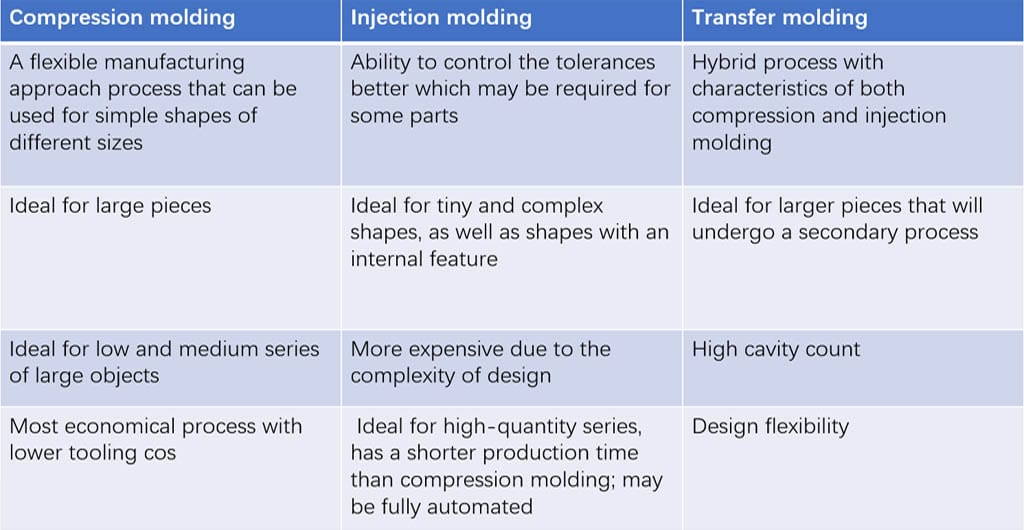
What is a Rubber Compression Set
The rubber compression set is a critical characteristic to evaluate in the context of elastomer molding. It refers to the ability of rubber to maintain its intended shape under compression for a defined period and at a particular temperature. The compression set is a key factor affecting the performance and utility of rubber components. It indicates the extent to which a rubber part can revert to its original form after being subjected to a specific load. This attribute is particularly significant for applications that rely on sealing capabilities or the precise positioning of rubber elements.
Rubber Compression Molding Tolerances
In the realm of rubber molding, tolerances denote the permissible deviations in the measurements of a molded product. A variety of elements can influence these tolerances, such as material contraction, the design of the mold, the incorporation of inserts, the trimming and finishing processes, distortion, and the conditions under which the product is stored. The most significant variable to account for is the contraction and expansion that occur due to changes in the environment, a phenomenon that affects all rubber products to some degree after they are demolded and cool down.
Rubber products are categorized into four levels of dimensional tolerances, labeled as A1-A4. It is essential for rubber producers and their clients to collaborate in selecting the appropriate tolerance grade that best aligns with the specific requirements of the product under consideration.
Understanding Compression Set in Rubber Materials
Elasticity is what makes rubber an ideal material for numerous industrial applications, but it also poses challenges in the molding process. To maintain a rubber product’s shape, precise calculations are essential, considering factors like flexibility, weight, pressure, and mechanical properties.
Compressive Strength of Rubber:
Compressive strength refers to the maximum load a rubber can handle before it deforms plastically. It’s different from tensile strength, which measures a material’s resistance to pulling apart.
Assessing Compression Set:
Compression set testing evaluates a rubber’s resilience after being compressed. A high resilience indicates suitability for gaskets, seals, or cushioning. Results are percentage-based, with lower percentages indicating better resistance to deformation. ASTM International offers testing methods for various rubber compounds.
Why Opting for Rubber Compression Molding
Compression molding is a versatile process suitable for producing rubber items in various sizes and quantities. Once the mold is made, it facilitates efficient mass production. This method minimizes waste by using preforms, ensuring material is precisely placed in each mold cavity, similar to portioning cookie dough for baking. Ideal for low to medium volume production and large parts needing extended cure times, it offers cost-effectiveness.
- Press and Mold Quality Vary:The efficiency of presses and mold cavities can impact production. Multi-cavity molds can enhance output, avoiding the limitations of less capable presses. Larger parts or molds necessitate presses with greater capacity, correlating press size with part size and cavity count.
- Economical for Various Runs:With lower tooling and setup costs, compression molding is well-suited for small to medium production runs and can handle large runs. It’s also effective for creating prototypes before scaling up.
- Mold Cavity Economics:Compression molds are cost-effective, with the number of cavities effect unit cost and press size needed to reduce cycle times. Prototyping often benefits from single-cavity molds for part validation, despite the same precision and effort required as for larger production molds.
Offering Standard and Custom Rubber Solutions
We cater to both standard and bespoke rubber part needs, tailored to your project’s timeline, design, and budget.
Standard vs. Custom Rubber Parts
Rubber manufacturers offer standard parts for quick, cost-effective installations where designs can accommodate off-the-shelf components. However, custom parts are ideal when time allows and designs require specific match. Custom options also enable brand integration and unique features.
Standard Offerings Include
- Molded items (grommets, bumpers, etc.)
- Vibration control (mounts, bushings)
- Extruded products
- Metal-bonded rubber items
Custom Solutions
Custom rubber parts are sought when existing parts are phased out, product updates are needed, or to fill market gaps. We’re here to assist with custom manufacturing to meet your specific requirements.
FAQs for Rubber Compression Molding
Here are some frequently asked questions about rubber compression molding
Durability of Compression Rubber Parts
Rubber parts have a finite lifespan, degrading over time due to environmental factors like temperature and exposure to fluids. Degradation can manifest as hardening or softening. Manufacturers can estimate a part’s lifespan using Finite Element Analysis (FEA) and accelerated environmental testing.
Shelf Life of Rubber Parts
The longevity in storage depends on the polymer, compound, and storage conditions. Some rubbers, like neoprene and SBR, may last 3-5 years, while silicone can last up to 20 years. Rubber should be kept in a cool, dry place, away from sunlight. Consult with manufacturers for specific elastomer shelf life.
How to control quality during rubber compression molding
Quality control involves many aspects such as mold design, material selection, temperature and pressure control, curing time, etc. By precisely controlling these parameters, the consistency and performance of rubber parts can be ensured.
Do compression molded rubber parts require post-processing?
Yes, compression molded parts may require post-processing steps such as deburring, post-curing, or performance testing to ensure the quality of the final product.
What is the production cycle for rubber compression molding
The production cycle depends on the type of rubber, mold design, curing time, and post-processing requirements. Some simple parts may be completed in a few minutes, while complex parts may take longer.
These FAQs provide basic information on rubber compression molding to help users better understand the characteristics and requirements of this manufacturing process.
Compression molding is a time-honored method utilized for shaping an array of items across various sectors, including industry, business, and everyday consumer goods.
By gaining a deeper understanding of these aspects of rubber compression molding, you can better grasp the intricacies of this manufacturing method and achieve the best results in your industrial applications.
Compression molding offers a cost-effective alternative to injection molding for manufacturing rubber items. To ensure the molded part meets your specifications, it’s crucial to focus on the mold-making phase, as it determines the final product’s quality.
If you’re seeking to mold or molded part, reach out to our team, and we’ll respond promptly!
